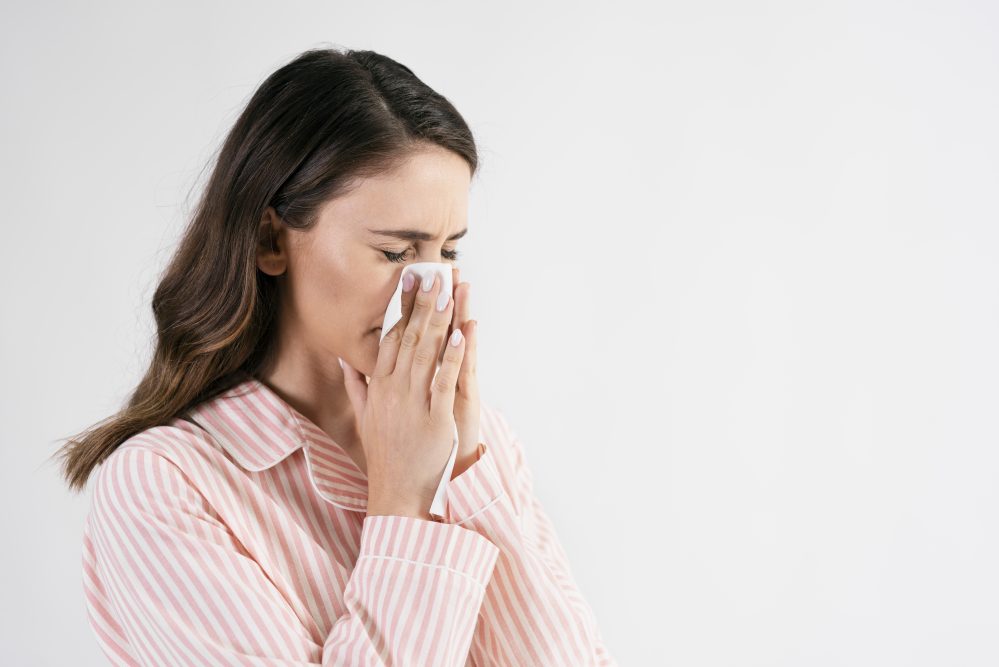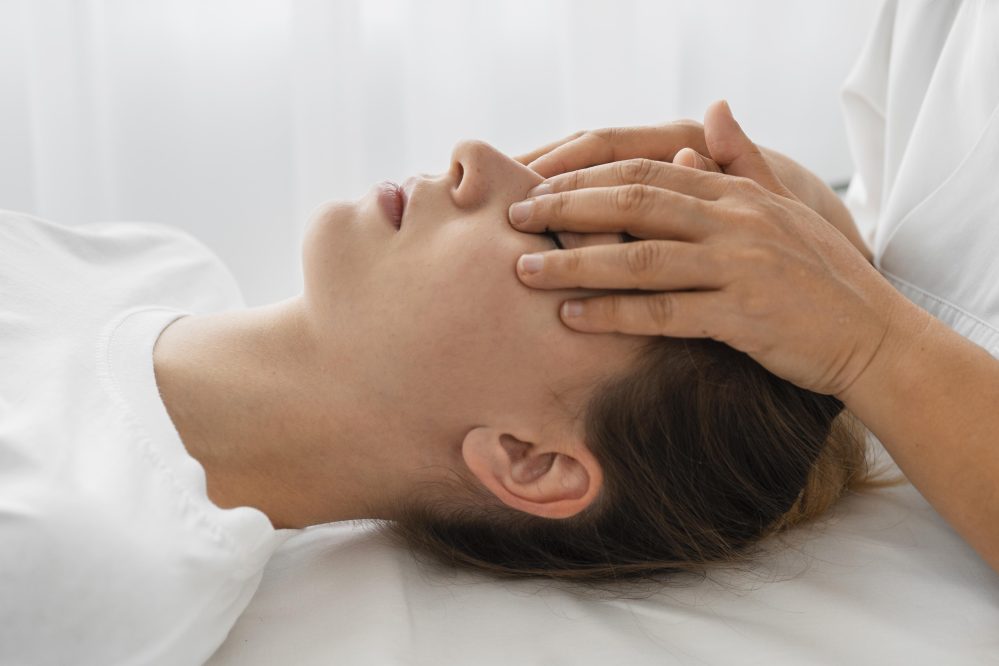You might’ve heard of sinuses before, but are you aware of their critical significance in many functions essential to well-being? As narrow cavities interconnected in the face and skull, sinuses navigate the production and movement of mucus and help prevent various infections.
However, like other bodily systems, the sinuses can become infected when attacked by viruses, bacteria, or fungi, necessitating the search for a remedy. In such cases, understanding the importance of acupressure as an alternative healing approach can be your gateway to reducing pain.
Whether you’re facing congestion, headaches, or sinus discomfort, this comprehensive guide will equip you with the knowledge to harness the healing potential of sinus pressure points. Say goodbye to sinus woes as we unravel the key acupressure points for effective pain relief!
What Are Sinuses?
Sinuses are air-filled cavities or spaces in the face. They are lined with a mucous membrane and connected to passages in the nose. Sinuses play a role in producing mucus, which is the slippery fluid that contains protective immune cells and runs through the nose. This process helps remove bacteria, allergens, dust, and other irritating particles to prevent infection.
Types of Sinuses
There are four main types of sinuses located in the face, and each corresponds to a specific bone which they are named after. Sinuses are important for many reasons, including their effect on lightening the weight of the skull and protecting it from trauma, modifying the voice tone, and producing mucus. Nevertheless, their function continues to be a subject of study.
The four types of sinuses are:
Frontal sinuses – Located in the frontal bone (forehead bone) above the eyes.
Maxillary sinuses – Situated in the maxillary bone (cheekbone) on either side of the nose. These are the largest sinuses.
Ethmoid sinuses – Found between the eyes and behind the nasal bridge in the ethmoid bone.
Sphenoid sinuses – Located behind the ethmoid sinuses, deep within the skull, and behind the eyes.

Sinus Infection and Symptoms
Sinus infections, or sinusitis, occur when harmful microorganisms like viruses, bacteria, or fungi invade the sinus cavities, leading to inflammation. This condition commonly develops after a cold or flu and can be categorized as acute or chronic. Acute sinusitis lasts for a shorter period, typically under four weeks, whereas chronic sinusitis lingers for 12 weeks or longer and may return multiple times throughout the year.
Common symptoms of sinusitis
The symptoms of sinusitis can be highly disruptive and uncomfortable, often affecting a person’s daily routine. Nasal congestion is usually one of the first signs, with patients experiencing a stuffy or runny nose. Facial pressure and pain are frequent, particularly around the forehead, nose, and eyes. Headaches, often concentrated in the forehead or behind the eyes, add to the discomfort, while postnasal drip frequently triggers a persistent cough, especially at night.
In more severe cases, patients may develop a fever, which is more common with acute sinus infections. Fatigue is another frequent symptom, as the body diverts energy to fight off the infection. Many people with sinusitis also notice a reduced ability to smell and taste due to inflammation. Also, bad breath, or halitosis, can result from excess mucus and bacterial buildup in the sinuses.
Treatment options and remedies
There are several ways to manage sinusitis symptoms, from medications to home remedies. Over-the-counter pain relievers such as ibuprofen or acetaminophen can help reduce inflammation and ease facial pain. Decongestants are another option to relieve nasal congestion, although they should only be used for short periods to avoid rebound congestion. In cases where a bacterial infection is responsible for sinusitis, doctors may prescribe antibiotics, particularly for chronic or severe cases.
In addition to medications, there are effective home remedies that can provide relief. Nasal irrigation with a saline solution is a popular method for flushing out mucus and irritants, promoting easier breathing. Hydration plays a crucial role, as drinking plenty of fluids helps thin the mucus, allowing it to drain more easily. Warm liquids like tea or broth can also soothe the throat and nasal passages. Steam inhalation is another technique to reduce congestion and calm irritated sinuses. Resting is equally important, as it supports the immune system in fighting the infection.
Alternative therapies and prevention
Some individuals turn to alternative therapies like acupressure to alleviate sinus pain. By applying pressure to specific points on the face and body, many report a reduction in discomfort, although scientific evidence supporting this practice is still evolving. Nonetheless, it remains a popular complementary treatment for those seeking non-medical approaches to pain relief.
Prevention is key to avoiding recurrent sinusitis. Reducing exposure to irritants and allergens like pollen, dust, or pet dander can significantly lower the risk of sinus inflammation. Additionally, practicing good hygiene, such as regular handwashing and avoiding close contact with people who are sick, helps prevent the spread of infections that can lead to sinusitis.

What Is Acupressure?
Acupressure is a healing technique often used in conjunction with the acupuncture treatment. It employs pressing the acupuncture body points to regulate the flow of “qi” (energy) along meridians and alleviate pain naturally. This helps promote the release of endorphins and neurotransmitters that contribute to pain relief.
As an alternative technique, acupressure comes from Traditional Chinese Medicine (TCM) and is similar to acupuncture; the main difference is that acupuncture uses needles, whereas acupressure is performed with fingers, hands, arms, or hand rollers.
Acupressure as a holistic approach has demonstrated significant effectiveness in resolving many health conditions, which resulted in the practice of acupressure in Western medicine. Similarly, acupressure is used to treat problems associated with sinuses, including sinusitis, by applying firm pressure in specific areas recognized as sinus pressure points.
Along with pain relief, acupressure contributes to stress reduction and relaxation, and promotes well-being. However, when facing serious issues, consulting with a healthcare professional for proper diagnosis and treatment is recommended.
What Are Sinus Pressure Points?
Sinus pressure points represent specific areas in the body that are believed to correspond to specific sinuses and are used during acupressure for sinus pain relief. One can stimulate these points at home by applying pressure using one’s fingers. It’s important to do so in circulatory movements or up and down.
According to TCM, stimulating these points can help alleviate pain and symptoms resulting from sinusitis or sinus congestion. While scientific evidence supporting the effectiveness of acupressure for sinus relief is limited, some people find it a complementary approach for managing sinus issues.
11 Sinus Pressure Points for Relief
Understanding various sinus pressure relief points is key to reaching positive results in acupressure. One must know where the main points are located and which sinuses they’re connected to. This will help tailor acupressure to treat specific conditions.
Here are the 11 most important sinus pressure points for pain relief:
- Governor Vessel 24.5 (GV 24.5) is located on the forehead, between the eyebrows. It is also known as the Third Eye. Stimulating this point is great for mucus drainage and headache relief.
- Bladder 2 (BL 2) is centered on the nose ridge, close to the inner corners of the eyes. Applying pressure to this point will affect sinus congestion and headaches and relieve pressure around the eyes.
- Large Intestine 4 (LI 4) is one of the hand points located on the back of the hand, specifically in the area between the thumb and index finger. Pressuring this point will ease sinus pain and headaches and release muscle tension.
- Large Intestine 19 (LI 19) can be found between the nostrils and the upper lip. Rubbing this point helps with nasal congestion and swelling and treats jaw disorders.
- Large Intestine 20 (LI 20) is situated on both sides of the nostrils. This pressure point is effective for swelling and other symptoms related to sinusitis.
- Stomach 3 (ST 3) is symmetrical to the area below the pupils and in line with the bottom of the nostril. It is targeted to alleviate sinus and dental pain and facial paralysis.
- Small Intestine 18 (SI 18) is situated in the hollow part of the cheekbone on the outer edge of the nose. Massaging this point helps with swollen sinuses and runny noses.
- Gallbladder 20 (GB 20) can be found on the back of the head, where the neck meets the skull. One should apply pressure to this point to relax the muscles and reduce neck pain. It is also thought to help with migraines.
- Lung 5 (LU 5) is located on the crease of the elbow. Stimulating LU 5 may help relieve a runny nose and treat respiratory issues, including coughing, sore throat, and abdominal pain.
- Lung 9 (LU 9) is located at the end of the wrist crease, under the thumb. Since it’s believed to be connected to the lungs, it can help with colds, asthma, and sinus infections.
- Liver 3 (LV 3) is situated on the groove between the big toe and index toe. Stimulating the LV 3 point helps reduce pain around the eyes, headaches, and stress.
When to Seek Medical Attention
While acupressure and other home remedies may provide temporary relief from sinus pressure and pain, there are certain symptoms that require professional medical attention. If you experience any of the following, it’s essential to consult a doctor promptly:
Prolonged sinusitis, especially when symptoms persist for more than ten days without improvement, clearly indicates that medical intervention may be necessary. A high fever is another red flag, often indicating a more serious infection. Intense headaches or facial pain that over-the-counter medications cannot relieve should also be addressed by a healthcare provider.
Additionally, if sinusitis affects your vision or you notice eye-related symptoms, such as swelling or pain around the eyes, it could be a sign of a more severe condition. Difficulty breathing, neck stiffness, or neck pain are also concerning symptoms that should not be ignored.
While symptoms of sinusitis can vary from person to person, if you are uncertain about the severity of your condition, it’s always better to err on the side of caution. Seeking immediate medical attention will ensure you receive the appropriate care and avoid complications.
Conclusion
Sinuses, the air-filled cavities within the skull and face, are critical in lightening the weight of the skull, offering resonance to the voice, and producing mucus. When inflamed, sinuses can cause many symptoms. Understanding key sinus pressure points is vital for individuals grappling with common sinus infections and symptoms. If you’re dealing with sinusitis or encountering other sinus-related issues, consider exploring acupressure as a potential solution. Employing the knowledge of sinus pressure relief points we’ve shared could serve as your pathway to effective pain relief!
Frequently Asked Questions (FAQs)
Does sinus pressure point stimulation work?
While the effectiveness of acupressure is backed up scientifically, many individuals claim that stimulating sinus pressure points helps reduce sinus infection, headaches, and nasal congestion.
Can you do acupressure for allergies?
Yes, acupressure can be utilized as a complementary approach for managing allergy symptoms. Stimulating specific acupressure points related to the respiratory system and immune function may help alleviate congestion, reduce inflammation, and promote overall well-being.
Is heat or cold better for sinus pressure?
Both heat and cold can provide relief for sinus pressure. Still, choosing between them often depends on preference and the specific symptoms.
Can sinus pressure cause dizziness?
Yes, sinus pressure can cause dizziness. When the sinuses become inflamed or congested, it can affect the balance mechanisms in the inner ear, leading to feelings of dizziness or lightheadedness.